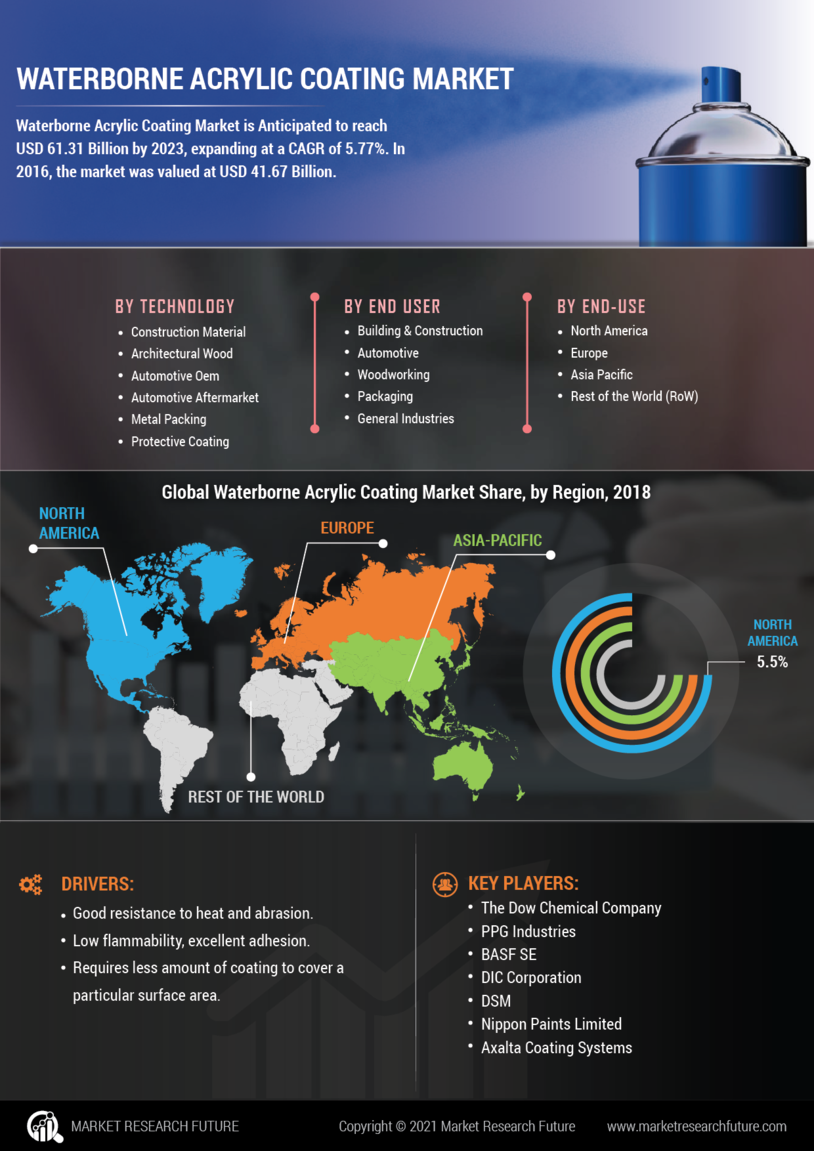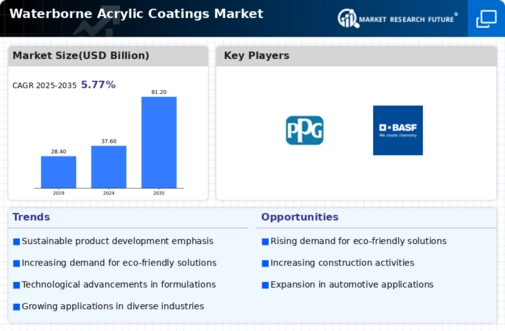Market dynamics, market share, market value, and market volume.
Market segmentation based on type and application.
Regional analysis, key market players, supply, demand, and competitive landscape of the market.
Factors influencing and hampering the market growth.
Approaches followed by the prominent market player to maintain market decorum.
Segment Overview:
By Application
The global waterborne acrylic coating market is segmented based on application as architectural wood, automotive aftermarket,
protective coatings
, construction material, automotive OEM, metal packing, and others.
By End User
The global waterborne acrylic coating market is segmented based on the end-user as construction, woodworking, general industries, building, automotive, packaging, and others.
By Resin Outlook
The global waterborne acrylic coating market is segmented based on Resin Outlook as Acrylic, Epoxy, Polyester, PVDC, Polyurethane, Alkyd, PTFE, PVDF, and Others.
Regional Analysis
The global waterborne acrylic coating market is segmented based on region as North America (The US and Canada), Europe (Germany, Italy, The U.K., France, Spain, Russia, and The Rest of Europe), APAC (China, Japan, India, and The Rest of Asia-Pacific), Latin America (Mexico, Brazil, and Argentina), The Middle East, and Africa.
Asia Pacific is the market-dominant of the global waterborne acrylic coating market accounting for maximum market shape in value and volume term. Because of vast infrastructural developments and rising construction business in developing countries like China, India, and Japan the waterborne acrylic coatings market is expected to have substantial growth. The shifting of the human population from rural to urban areas gave rise to rapid urbanization and has also proved to be driving the waterborne acrylic coating market in the Asia-Pacific region.
Automotive sectors have also added to the promotion of the waterborne acrylic coating market in the region offering lucrative opportunities.
A moderate growth of the waterborne acrylic coating market is seen in the regions of Europe and North America due to a comparatively developed economy but is expected to rise in upcoming years seeing to the economic crisis the regions recently suffered. With a drop in the price of crude oil automotive industry is making way for the waterborne acrylic coating industry in the region.
Other economically emerging economies like The Middle East, Africa, and Latin America have seen a trend like that of the Asia-Pacific region.
Acrylic Based Waterborne Coatings Market Industry Developments
Q2 2024: PPG Launches Next-Generation Waterborne Acrylic Coating for Automotive OEMs PPG Industries announced the launch of a new waterborne acrylic coating system designed for automotive original equipment manufacturers, offering improved environmental performance and faster curing times.
Q2 2024: AkzoNobel Opens New Waterborne Coatings Facility in China AkzoNobel inaugurated a new manufacturing facility in Changzhou, China, dedicated to the production of waterborne acrylic coatings for the Asian automotive and industrial sectors.
Q3 2024: BASF Expands Waterborne Acrylic Resin Production in Germany BASF announced the expansion of its Ludwigshafen site to increase production capacity for waterborne acrylic resins, supporting growing demand in the European coatings market.
Q3 2024: Sherwin-Williams Launches Low-VOC Waterborne Acrylic Coating for Architectural Applications Sherwin-Williams introduced a new line of low-VOC waterborne acrylic coatings targeting the architectural segment, emphasizing sustainability and compliance with stricter environmental regulations.
Q4 2024: Axalta Announces Strategic Partnership with BYD for Waterborne Automotive Coatings Axalta Coating Systems entered a partnership with BYD to supply waterborne acrylic coatings for BYD's electric vehicle production lines in China.
Q4 2024: Nippon Paint Launches Eco-Friendly Waterborne Acrylic Coating for Southeast Asia Nippon Paint introduced a new eco-friendly waterborne acrylic coating product line for the Southeast Asian market, focusing on green building and infrastructure projects.
Q1 2025: PPG Completes Acquisition of Specialty Waterborne Coatings Producer in Europe PPG Industries completed the acquisition of a European specialty manufacturer of waterborne acrylic coatings, expanding its portfolio and regional presence.
Q1 2025: AkzoNobel Signs Supply Agreement with Tesla for Waterborne Acrylic Coatings AkzoNobel secured a multi-year supply agreement to provide waterborne acrylic coatings for Tesla's automotive manufacturing plants in Europe.
Q2 2025: BASF Launches Bio-Based Waterborne Acrylic Coating for Industrial Applications BASF introduced a new bio-based waterborne acrylic coating targeting industrial customers seeking sustainable and high-performance solutions.
Q2 2025: Sherwin-Williams Opens R&D Center Focused on Waterborne Acrylic Technologies Sherwin-Williams opened a new research and development center in the United States dedicated to advancing waterborne acrylic coating technologies.
Q3 2025: Axalta Wins Major Contract to Supply Waterborne Acrylic Coatings for European Rail Project Axalta secured a contract to supply waterborne acrylic coatings for a large-scale European rail infrastructure project, supporting sustainability goals.
Q3 2025: Nippon Paint Appoints New CEO to Drive Waterborne Coatings Expansion Nippon Paint Holdings appointed a new CEO with a mandate to accelerate the company's growth in the waterborne acrylic coatings sector globally.
Report Overview:
The report overview of the global Waterborne Acrylic Coatings Market report is:
Market dynamics, market share, market value, and market volume.
Market segmentation based on type and application.
Effect of the global pandemic on the market.
Regional analysis, key market players, and competitive landscape of the market.
Factors influencing the market growth.
Opportunities created by the market.
Factors hampering the market strategies.
Approaches like bottom-up and top-down followed by the prominent market player to maintain competition.
A detailed and comprehensive outlook on historical and current market trends.
Expected revenue and CAGR during the forecast period.
Supply and demand region-wise.
The increasing demand for environmentally friendly and low-VOC coatings is reshaping the landscape of the waterborne acrylic coatings market, as industries seek sustainable solutions to meet regulatory standards and consumer preferences.
U.S. Environmental Protection Agency (EPA)













Leave a Comment